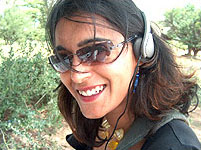|
Intermix.org.uk is a website for the benefit
of mixed-race families, individuals and anyone who feels they have a multiracial
identity and want to join us. Our mission is to offer a view of the mixed-race experience, highlighting icons, film, books, poetry, parenting techniques, celebrities, real lives and much more. Our online forums are a great place to meet others, ask questions, voice your opinions and keep in touch. Sign up for our monthly newsletter and delve into our pages. Want to join in? Become an Intermix member to take part: |
The Elephant In The Room
Tanya Datta

There is an elephant in the kitchen of race relations. Actually, it's not in the kitchen, but more in the spare bedroom of race relations. Tucked away at the top of the house, it's been ignored for so long that it's become very comfortable and will prove hard to extract. No one can tell if it's an African or Indian elephant anymore. What is clear, though, is that someone's still feeding it.
Inter-ethnic racism - the prejudices that exist between Britain's two largest ethnic minorities, the Black and Asian communities - is the uncomfortable subject that no one wants to talk about. Until, that is, it blows up in our faces as happened in October 2005 when the deprived Birmingham suburb of Lozells was torn apart by race riots. That's race riots between Asian and Black Britons, not whites.
That night as hundreds rioted, a black IT worker, Isaiah Sam-Young aged 23, was fatally stabbed. Months later, three Asian men were given life imprisonment for his murder. The judge at their trial commented that Sam-Young had been killed for no other reason than the colour of his skin.
Perhaps for mainstream white society, this comment and what it signifies is puzzling. After all, Asian people are brown-skinned too. Like African-Caribbean people, their shades range from parchment to ebony, so how can skin colour be of any real import? Yet despite sharing their non-whiteness, their marginalisation and their common history of struggle against discrimination on these shores, I have discovered that there are deep tensions between these two communities that are implicitly understood by them, even if they are hidden from the eyes of mainstream society.
Last year, I made a documentary for BBC Radio 4 about mixed race Asian and Black couples, a phenomenon that is not just rare, for many people of colour, it is still taboo. In it, Rena, an Asian woman, told me the marital advice she had received from her father when a teenager. "The first choice for marriage is someone in your own community...and then after that, white is the next best thing...and after white, any other race in the world but black."
The fetishization of pale skin is shared by both the Asian and the Black communities. Skin products containing bleach are still eagerly snapped up despite evidence of the damage they do. But the depth of intolerance that I uncovered within these communities, which often confronts relationships of this kind, goes beyond a simple 'white is best' aesthetic. There is a more fundamental antagonism at play. But no one is talking about it. Why? I suspect because it is too tricky.
While the 2001 census figures show that the United Kingdom has one of the fastest growing mixed race populations in the world, closer study reveals in fact that it is broken down into just two categories: the offspring of white and black people or white and Asian people. There are no official statistics about unions between Asians and African-Caribbeans. In fact, when I started my research, many black and Asian colleagues told me outright that these types of couples simply did not exist. Some went further and claimed they could not exist. But they were wrong. They do.
In the course of my research, I, along with a black colleague, literally walked the streets of London's most ethnically mixed areas to talk to ordinary people on the ground. We located and talked to numerous interracial Asian and Black couples across the country with diverse experiences. Hardly any, however, were willing to go on the record.
There seemed to be a fear that revealing these hidden antagonisms could be seen as a betrayal of their families, communities and even of their race. And for some, there was a perception that it was an unwelcome distraction from the battle against dominant white racism.
But some couples did agree to speak out.
"Asian and black people when I was growing up didn't really mix," Teresa (not her real name) a Londoner of Nigerian descent told me. "You didn't go into their homes and they didn't come into your homes. That happened more with the white children than with the Asian children." Today, Teresa is happily married to Asif, (not his real name), a Pakistani-born Brummie, but their journey to marriage was not obstacle-free.
Leon and Sheela live in a predominantly Asian part of Birmingham. For them, just leaving the house together can be a nightmare. They are subjected to rude comments and occasionally, Sheela has been loudly questioned by Asian shopkeepers as to why she is with a black man. Their experiences reminded me of stories of black and white couples in 1950s Britain. But this is happening today over 50 years later.
Opposition to Asian and Black mixed race relationships can come from both sides although in most of the cases I explored, it stemmed from the Asian families.
One Jamaican woman, however, told me about how her mother once sat in the living room and abused her Sri Lankan husband. Her mother's justification was that Asian people thought that they were better than black people.
Certainly, as some sections of the Asian community prosper, there is a perception of contempt from them that is cited by certain quarters of the Black community as the reason for arousing their ire. In turn, many Asians blame a perception of resentment and envy by some of the African-Caribbean community towards them. Whatever the truth of the matter, this sensitive issue needs to finally come out of the closet and have a wider airing.
There was a moment in the 1980s when it seemed to me, politically at least, as if Asian and black people stood united against the forces of discrimination. In those days, I, along with many of my peers, used to describe myself as black. That era is long gone. If we do not confront our reluctance to tackle inter-ethnic racism headlong because of political correctness, then the risk is of ever-increasing fragmentation.
This paper was first submitted as part of the e-conference mixedness and mixing 4-6 September 2007.
